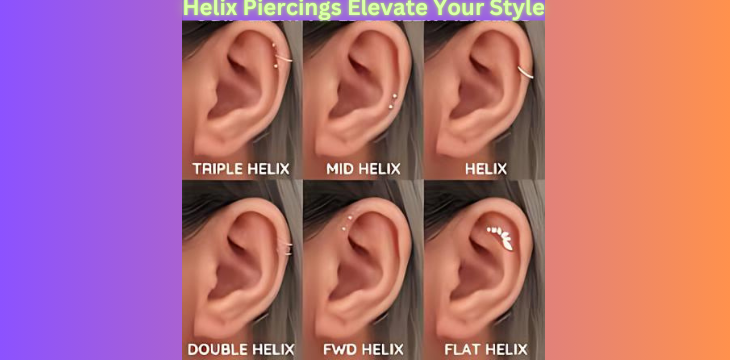If you’re itching to add a bit of edge to your look, a helix piercing might just be the perfect choice. This trendy ear adornment isn’t just about looking cool; it’s also about making a statement. Whether you’re considering your first helix piercing or you’re a seasoned pro looking to learn more, this guide has got you covered. Buckle up as we dive into everything you need to know about helix piercings, from the basics to advanced tips.
Table Of Contents
What a Helix Piercings?
A helix piercing is one of the most popular types of cartilage piercings. Located on the upper part of the ear’s outer rim, it offers a sleek, modern aesthetic that can be both subtle and striking.
Here’s the lowdown:
- Location: The upper, outer part of the ear.
- Jewelry Options: Hoop, stud, or barbell.
- Pain Level: Typically mild to moderate, depending on your pain tolerance.
Different Styles of Helix Piercings
Thinking about getting a helix piercing? You’ve got options! Let’s break down some of the most popular styles.
Single Helix Piercings
- Description: Just one piercing on the upper rim of the ear.
- Look: Simple and classic.
- Jewelry: A tiny stud or a delicate hoop can work wonders.
Double Helix Piercing
- Description: Two piercings stacked vertically on the outer rim.
- Look: Adds a bit more flair.
- Jewelry: Consider using matching studs or hoops for a cohesive look.
Triple Helix Piercings
- Description: Three piercings along the helix.
- Look: Edgy and bold.
- Jewelry: Mix and match different styles for a unique appearance.
How to Choose the Right Jewelry
Selecting the right jewelry is crucial for both comfort and style. Here’s what you need to keep in mind:
- Material Matters: Opt for hypoallergenic materials like titanium or surgical steel, especially if you have sensitive skin.
- Size Counts: Make sure the gauge (thickness) and length of the jewelry are suitable for your ear.
- Style: Choose a style that complements your personality and fits well with your existing piercings.
The Helix Piercings Process: What to Expect
Getting a helix piercing is a straightforward process, but knowing what to expect can ease any nerves. Here’s a step-by-step rundown:
- Consultation: Talk to your piercer about your desired style and any concerns.
- Preparation: The piercer will clean and mark the spot.
- Piercing: Using a sterilized needle, the piercer will create the hole and insert the jewelry.
- Aftercare Instructions: You’ll be given advice on how to care for your new piercing.
Tips for a Smooth Piercing Experience
- Choose a Reputable Piercer: Make sure they follow strict hygiene standards.
- Avoid Touching: Try not to touch or twist the piercing while it’s healing.
- Stay Calm: Deep breaths can help if you’re feeling anxious.
Aftercare for Your Helix Piercings
Proper aftercare is essential to ensure your piercing heals well and doesn’t get infected. Here’s a quick guide:
Cleaning Routine
- Solution: Use a saline solution or sea salt soak.
- Frequency: Clean the piercing twice a day.
- Avoid: Harsh chemicals or alcohol-based products.
What to Avoid
- Swimming: Stay away from pools, hot tubs, and lakes during the healing process.
- Sleeping on It: Try to sleep on the opposite side to avoid irritation.
- Changing Jewelry Too Soon: Wait until the piercing is fully healed before swapping out jewelry.
Common Concerns and FAQs
Let’s tackle some frequently asked questions and common concerns about helix piercings.
Is a Helix Piercing Painful?
Most people describe the pain as a sharp pinch that fades quickly. It’s usually more uncomfortable than an earlobe piercing but less painful than you might think.
How Long Does It Take to Heal?
Healing times can vary, but a helix piercing generally takes about 3 to 6 months to heal. Some people might experience a bit of swelling and redness during the initial weeks.
Can I Change My Jewelry Early?
It’s best to wait until your piercing is fully healed before changing your jewelry. Changing it too soon can increase the risk of infection or irritation.
What Should I Do if My Piercing Gets Infected?
If you notice signs of infection—like increased redness, swelling, or pus—consult your piercer or a healthcare professional. They can provide guidance and treatment options.
Conclusion
Helix piercings are more than just a trend—they’re a bold fashion statement and a way to express your individuality. With the right care and attention, your helix piercing can be a stunning addition to your look. Remember to choose a reputable piercer, follow aftercare instructions diligently, and enjoy the journey of rocking your new piercing.


